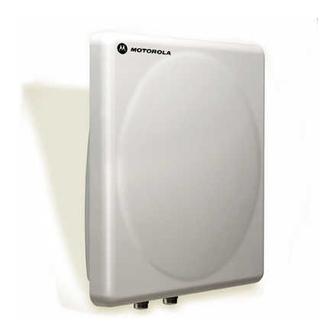Table of Contents
Advertisement
Quick Links
Advertisement
Chapters
Table of Contents

Summarization of Contents
Important safety information
Power lines
Exercise extreme care when installing antennas near power lines.
Working at heights
Exercise extreme care when working at heights.
Grounding and protective earth
Proper grounding of the Outdoor Unit (ODU) is essential for lightning protection.
Grounding PTP-SYNC
Grounding requirements for PTP Sync unit in Australia and New Zealand.
PIDU Plus
Recommendation to use the supplied PIDU Plus to power the ODU.
Powering down before servicing
Always power down and unplug equipment before performing any servicing.
Cable measuring card
Warning about using a cable measuring card at the ODU end.
Non-Motorola power supply
Safety may be compromised if a non-Motorola power supply is used.
Alternative DC supplies
Requirements for using alternative DC supplies with PIDU Plus.
Primary disconnect device
The main power supply serves as the primary disconnect device.
External cables
Safety may be compromised if outdoor rated cables are not used.
RF exposure near the antenna
Mute transmitter before maintenance in front of the antenna due to RF fields.
Minimum separation distances
Maintain minimum separation distances from all persons for PTP 600 ODUs.
General information
Purpose
Manual is intended to instruct and assist personnel in operation, installation, and maintenance.
Cross references
References to external publications shown in italics; blue text links to references in electronic versions.
Contacting Motorola
Feedback
Appreciation for feedback on structure, content, accuracy, or completeness of documents.
Motorola Point-to-Point
Contact details for Motorola Point-to-Point products and services.
WiBB Technical Support telephone numbers
Provides telephone numbers for technical support across various regions.
Reporting problems
Procedure to investigate and report problems encountered during installation or operation.
Repair and service
Contact information for unit repair or service through the PTP Global Technical Support Center.
Warranty
Details Motorola's standard hardware warranty for one year from shipment.
Chapter 1 Product description
Product function
Describes the function of the PTP 600 Series bridge and its technologies like OFDM and MIMO.
Typical deployment
Illustrates a typical PTP 600 Series bridge deployment connecting two buildings.
Product variants
Details the different frequency variants of the PTP 600 Series and their specifications.
Outdoor unit (ODU)
Describes the ODU as a self-contained unit housing radio and networking electronics.
PIDU Plus PTP 300/500/600 Series
Explains the PIDU Plus's role in supplying voltage and its front panel indicators.
Cables and connectors
Covers outdoor and indoor connections, supported cables, and connectors.
PTP and lightning protection
Provides instructions for protecting PTP 600 installations against lightning strikes.
Wireless operation
Details wireless operation, including Time Division Duplex (TDD) and link modes.
Ethernet bridging
Explains how the PTP 600 Series functions as a transparent Ethernet bridge.
System management
Describes system management features like management agent, web interface, and installation wizard.
FIPS 140-2
Details the optional secure cryptographic mode validated to Federal Information Processing Standards Publication 140-2.
Chapter 2 Planning considerations
Spectrum planning
Information on planning spectrum use, including radar detection and frequency selection.
Licenses and region codes
Details region codes and license keys to control radio link operation according to local regulations.
Radar avoidance and bandwidth operation
Covers radar avoidance requirements and variable channel bandwidth operation.
Variable channel bandwidth operation
Explains how to select Channel Bandwidth based on PTP frequency variant and available spectrum.
Site planning
Guidelines for selecting installation locations for ODU and PIDU Plus.
Link planning
Explains link planning using PTP LINKPlanner for known quality installations.
Path loss considerations
Discusses path loss calculation and its impact on radio signal attenuation.
Planning synchronized networks
Information on planning TDD synchronization using LINKPlanner and available configurations.
System threshold, output power and link loss
Details system threshold, output power, and link loss for each frequency variant and modulation mode.
Lightning protection
Provides instructions for protecting PTP 600 installations against lightning strikes.
Chapter 3 Legal information
Motorola Inc. end user license agreement
Terms and conditions of the end user license agreement for Motorola software and documentation.
Hardware warranty
Details Motorola's standard hardware warranty.
Limit of liability
Outlines Motorola's total liability for damages related to the product.
Chapter 4 Reference information
PTP 600 general reference information
General reference information and regulatory notices common to all PTP 600 products.
PTP 25600 reference information
Reference information specific to the PTP 25600 frequency variant.
PTP 45600 reference information
Reference information specific to the PTP 45600 frequency variant.
PTP 48600 reference information
Reference information specific to the PTP 48600 frequency variant.
PTP 49600 reference information
Reference information specific to the PTP 49600 frequency variant.
PTP 54600 reference information
Reference information specific to the PTP 54600 frequency variant.
PTP 58600 reference information
Reference information specific to the PTP 58600 frequency variant.












Need help?
Do you have a question about the PTP 58600 and is the answer not in the manual?
Questions and answers